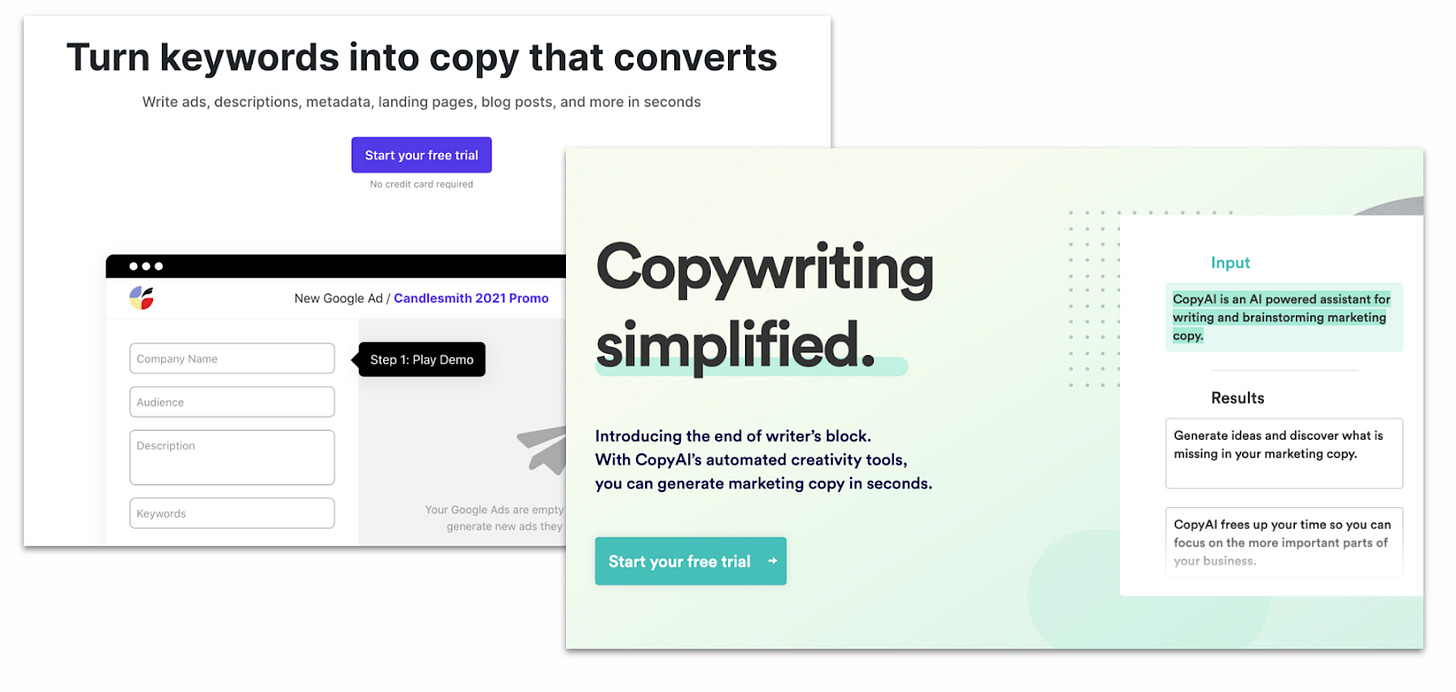Audience as a career moat
How to engage an audience that serves your professional goals

This post was originally published in The Jungle Gym.
Copywriting has long been billed as the “six-figure skillset” that every marketer should learn.

That perception cracked last June, with the launch of GPT-3. Beta-users immediately started using the language prediction algorithm to publish text that was nearly indistinguishable from human writing and launch tools to auto-generate marketing copy.
Though copywriting has not yet been commodified, that day is not far off.

Copywriting isn’t the only skill at risk of commodification.
Gartner predicts that by 2022 90% of large companies will have adopted some form of automation technology. The deployment of these tools will commodify skills across the professional landscape.
In the face of this upheaval, how can workers fortify their careers to keep the forces of disruption at bay?
The New Career Moat
A career moat is a professional advantage that protects your long-term employment prospects from economic forces.
While rare and valuable skills were once seen as solid career fortification, automation and artificial intelligence seem poised to render many skills obsolete.
To defend your career prospects in the decades ahead, you need an advantage that will be hard for machines to replicate.
One domain where humans seem likely to retain our edge over machines is our ability to influence other people. While machines may find ways to entertain and inform us, we humans are evolutionarily predisposed to take cues about what products to buy, politicians to vote for, and companies to work for, from other members of our species. Given the immense economic value of these choices, our ability to influence one another will likely remain a sustainable advantage for the foreseeable future.
What does this mean?
Put simply, building a large audience is a good strategy for anyone who wants to build a resilient career.
Beyond mere downside career protection, an engaged audience can also help with:
- Fundraising – legitimizing you with potential investors
- Job Searching – putting your ideas in front of prospective hiring managers
- Recruiting – building relationships with possible hires
- Customer Acquisition – creating a marketing channel to reach customers
- Relationship Building – lubricating relationships with interesting people
- Idea Generation – connecting you with people who can expand thinking
In the past year, I’ve advised dozens of people who were at the beginning of their journey building audiences.
Using the learnings from these conversations and building my own newsletter, I’ve assembled this guide to help you align your audience-building efforts with your long-term professional goals.
Here’s what this guide will cover:
- Defining professional goals
- Targeting the ideal audience
- Uncovering audience needs
- Building a vehicle for engagement
- Reaching and retaining an audience
Let’s get into it.
Define your professional goals
Consider the following sentence:
In order to become a [insert professional goal], I need to build an audience of [insert audience type] so I can [insert reason].
Many new audience builders do not find this sentence easy to complete. In particular, they get hung up on defining their professional goals.
While setting career goals can be daunting, it’s still worthwhile. The risk of skipping this step is that you can miss out on your optimal audience and instead spend your time in a way that distracts from--rather than enhances--your career.
To demonstrate the value of setting career goals first, consider how the above sentence might read differently depending on your objectives:
- An aspiring investor might write:
In order to become a seed-stage fintech investor, I need to build an audience of fintech founders so I can generate enough deal flow to attract investment from LPs. - Here’s a version for an up-and-coming senior executive:
In order to become a senior executive at my company, I need to build an audience of junior talent so I can prove to my CEO that I'm capable of attracting talent. - Lastly, a version for an independent consultant:
In order to become an independent marketing consultant, I need to build an audience of senior marketers so I can generate inbound leads for my practice.
If you’re having trouble defining your goals, here’s a quick exercise that might help.
Target the ideal audience
With your goals in mind, it becomes easier to answer the question of who you should be targeting with your audience-building efforts. As a thought exercise, consider the following questions:
- Who are the gatekeepers who will determine whether I succeed on my future career path?
No matter what you want to do with your career, you need to win over someone to get the resources and legitimacy you need.
An aspiring author might need to impress literary agents, book publishers, and magazine editors. A startup founder may need to enlist investors, customers, and potential co-founders.
To figure out what gatekeepers you need to impress, ask some people who already have the career you want. - What kind of relationships will legitimize me in my role?
Rather than directly engaging future gatekeepers, you may instead want to target an audience that your gatekeepers will find impressive.
For example, an aspiring author might want to build an audience of likely readers, to make the case that publishers should take him seriously. Likewise, a future founder may want to build an audience of potential buyers to impress her future investors.
To uncover what kind of audience would entice your future gatekeepers, ask them directly or ask those who’ve needed their blessing. - What kind of audience does my future employer need to reach?
You can also build an audience that will directly benefit the type of companies you aspire to join.
For example, if you have an audience full of potential customers and employees for your dream company, it will surely help you make the case that they should hire you.
Uncover your audience’s needs
With the answers to these questions in mind, you hopefully have a better idea of your:
- Professional goals
- Ideal audience
- Reasons for engaging this audience
Once you can use those inputs to fill out the original sentence, we can then add a second statement:
In order to become a [insert role], I need to build an audience of [insert audience type] so I can [insert purpose].
I plan to engage this audience by filling their need for [insert need] by creating [insert vehicle for engagement].
To fill out the new sentence start researching your audience’s needs and pain points. You can do this in a variety of ways, including:
- Direct interviews
- Conversations with subject matter experts
- Researching what they are reading
- Joining communities and listening in on conversations
Any decisions they’re struggling with or information they are lacking should give you a clue of how you might provide value for them.
Ideally, you want to come away from your research with a rough persona that helps you answer questions about your audience’s:
- Demographics
- Career history and ambition
- Personal Interests
- Goals
- Media consumption habits
- Key influences
- Challenges and pain points
Build your vehicle for engagement
With a better understanding of your audience, it’s time to build your vehicle for engagement. This could be a podcast, newsletter, community, or whatever medium you believe will:
- Address the needs of your audience
- Deliver the type of value you are uniquely capable of creating
- Align with your abilities
To help you figure out what type of vehicle makes sense, try answering the following questions:
- What topics are you knowledgeable about, that you plan to continue studying?
- Which skills are you good at, that you plan to continue improving?
- What information streams do you have access to that others don’t?
- What relationships do you have access to that others don’t?
- What uncommon experiences are in your past that may persist into your future?
- What topics and activities bring you energy and enjoyment?
As Dilbert cartoonist Scott Adams advises, you don’t necessarily need to be a world-leading expert on a topic or a master at a certain skill to leverage it. Instead, you can pick two different things that you are top 25% at and find their intersection.
Everyone has at least a few areas in which they could be in the top 25% with some effort. In my case, I can draw better than most people, but I’m hardly an artist. And I’m not any funnier than the average standup comedian who never makes it big, but I’m funnier than most people. The magic is that few people can draw well and write jokes. It’s the combination of the two that makes what I do so rare. And when you add in my business background, suddenly I had a topic that few cartoonists could hope to understand without living it.
For example, from your years as an executive recruiter, you might have top 25% knowledge about the hiring process and comp negotiation. If you also happened to be a top 25% public speaker, you could easily create a great podcast about job-hunting for senior executives.
If you’re having trouble figuring out what things you are top 25% at, try Stew Fortier’s tactic and ask your friends: "what would you pay me to do for you?"
With those answers in mind, hopefully, you have the information you need to complete the full prompt from above. Back to our original examples:
- Startup Investor
In order to become a fintech startup investor, I need to build an audience of seed-stage fintech entrepreneurs so I can generate enough deal flow to attract investment from LPs.
I plan to engage this audience by filling their need for camaraderie and market insight by creating an exclusive community for promising fintech leaders. - Senior Executive
In order to become a senior executive at my company, I need to build an audience of junior talent so I can prove to my CEO that I'm capable of attracting talent.
I plan to engage this audience by filling their need for career advice by creating a video series where I give advice about common career questions faced by junior talent. - Independent Consultant
In order to become an independent consultant, I need to build an audience of senior marketers so I can generate inbound leads for my practice.
I plan to engage this audience by filling their need for fresh marketing insight by creating an aggregated collection of growth experiments and outcomes from my network of other independent marketing consultants.
Reaching and Retaining Audience Members
I wish I could say the hard part was over.
In reality, it’s just beginning.
Whether you’re starting an online course or an in-person series of events, it’s time to put in the work and start building.
While the playbook for growing a podcast audience will be different from that of growing a community, here are a few principles that apply to audience building no matter what kind of engagement vehicle you’re trying to build:
- Start with your inner circle – The first members of your audience are likely to be your friends and family members. Ask them to be patient as you figure out what you’re doing. Keep up a regular cadence and ask for lots of feedback. Pay special attention to the feedback of anyone who is a close match with your target audience persona.
- Ask for referrals – Once you’re getting consistently good feedback, send personalized messages to engaged members of your audience asking if they’d be willing to refer a friend or colleague who might be interested. If the referrals start coming, it’s a sign that you are ready to pursue the type of audience that you built your vehicle to engage.
- Find out where your audience is hanging out – Are they talking to each other on Twitter, posting in an obscure Subreddit, or connecting in a Slack community? Wherever they are, find your way into the conversation.
- Start adding value – Before you start advertising what you’re working on, try generating some goodwill. As you build up social capital, you will find openings to share what you’re building and invite others to join.
- Find a way to retain them – Give them a taste of value, and in exchange ask for some personal information that will give you a way to communicate with them directly. This could be an email or a phone number. You just want some way to communicate with them outside of the platform where you originally found them.
- Share widely and natively – when you release a new blog post, podcast episode, or video, get comfortable sharing widely. You’ll also have a lot more success if you learn how to share it in a way that feels native in each channel.
- Deliver consistent value and referrals will come – Ultimately if you’re creating consistent value for the people who are giving their attention, your audience will grow.
There’s more than one way to grow an audience
At this point, I should admit something–I didn’t follow this playbook when I started The Jungle Gym.
I share this to reassure you that if this prescription doesn’t feel right, it isn’t the only way to build an audience. It is simply one way.
That said, if I were starting completely fresh today, this is the framework I would use to decide what kind of audience and engagement vehicle to build.
But, the important thing isn’t the method you follow; what matters is the outcome you land on. Even if your career feels secure. Even if your audience ends up being just your close friends. I would encourage you to give audience-building a shot. There’s something special about building something of your own to communicate with people who are willing to give you their attention.
If I can be helpful, don’t hesitate to reach out.
